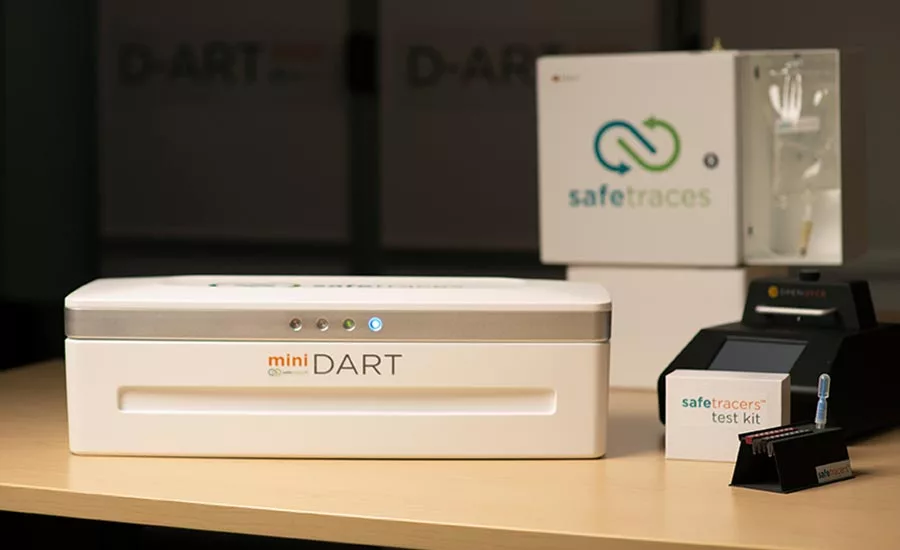Engineering R&D
DNA-based solution tracks fruit, produce, oils, grains


SafeTraces’ DNA-based, item-level traceability solution, called miniDART, can prove product authenticity.
Photo courtesy of SafeTraces
Over the years, this column has explored some novel solutions to tracking and tracing products in the supply chain—solutions that can help spot food fraud or simply let a producer/processor know where its product is, where it’s been and how long it spent traveling from point A to B. The problem is that most solutions have used the packaging as the vehicle to support bar codes or other data necessary for tracing a product’s journey. What happens if the product gets separated from its packaging?
Now a new technology answers that question and promises not only to track high-value products subject to fraud but also dry, bulk commodities like grain. How so? Imagine a bar code so small that it’s the size of DNA strands. In fact, the “bar code” is constructed of DNA strands from seaweed, is FDA-affirmed GRAS, and can be safely applied to fruits, grains, produce and other foods. With this technology, billions of bar code permutations can be created, and food treated with these DNA strands can be inspected with a simple machine capable of being operated by anyone to “read” the bar code.
SafeTraces Inc. was recently granted a U.S. patent, “DNA Based Bar Code for Improved Food Traceability,” which discloses a ground-breaking method for encoding and decoding digital information to and from DNA strands drawn from seaweed. It allows food and agricultural industries to create and apply unique, edible, flavorless DNA bar codes directly to food—not the packaging.
According to SafeTraces founder and CEO Anthony Zografos, PhD, these bar codes, called safeTracers, carry complete source data, stay on or in the food throughout the supply chain, and can be read in minutes to confirm provenance and purity of any food item. I asked Zografos to tell us more about safeTracers and the technology to read them, called miniDART.
FE: What is the company’s mission?
Anthony Zografos: We started the company in 2015, although work had already begun as early as 2013. Our mission is to make the food supply safer, more transparent and less wasteful. We do this by developing cutting-edge food safety and traceability solutions that empower growers, processors and consumers with meaningful, rapid and actionable information in order to make better decisions, particularly around procurement and risk reduction.
FE: Tell us more about how safeTracers work.
Zografos: Existing traceability systems are complex and only effective if everyone in the supply chain fully complies. A single error can make a traceback investigation impossible. As a matter of fact, many—if not most—traceback investigations are inconclusive. When a product crosses a national border, traceability becomes very difficult if not impossible. Our solution cuts through all that. It links the product directly to the point where either value is added or risk is introduced. For example, if you want to know whether the palm oil in your candy bar is sustainable, you really only care about where it was harvested. The dozens of nodes between the palm tree and the candy bar are not really that important.
For food safety, the situation is similar. Most risk is added either at the farm or at the processing step. What happens when the product travels from distributor to exporter to importer to distributor, etc. is not as important. But if a single supply chain actor drops the ball, then we know nothing. We really throw the baby out with the bath water because we fixate on knowing everything when what we really need to know is one thing. Our solution can link the product directly to those one or two key nodes, as well as integrate with existing traceability systems to essentially convert case-level traceability to item-level traceability with minimum incremental effort and cost.
FE: Can it work with edible oils or juices?
Zografos: Absolutely. We have active projects in commodities like palm oil, canola oil, and we are working on olive oil. We have successfully tested the DNA bar codes with a number of liquids, such as fruit juices, alcoholic beverages—even chemicals—and we’ve so far had only good results. As with every technology, there are limitations. But we are very creative and we can usually find a solution around challenging product chemistries or process conditions.
FE: How does a processor get safeTracers to code products?
Zografos: Our miniDART system works almost exactly like a printer—a DNA printer. It is a small device that easily retrofits into most production facilities. We provide the refill (think of it as the—invisible!—ink refill) and the software platform. The customer creates bar codes on site on demand in minutes and applies them to the product.
FE: Can miniDART read the code at any point in the supply chain?
Zografos: Absolutely. We have developed a very simple way to read the bar code, and it involves just a small portable device. You can read the bar code on production floors, warehouses, retail stores, even in your car. You only need our “test kit,” which is a very small strip; you can fit a dozen or more strips in your back pocket.
FE: How does the DNA/bar code material adhere to a product? How long can the bar code still be read?
Zografos: In some cases (such as apples, citrus, stone fruit, tomatoes, cucumbers, etc.), we incorporate the DNA/bar code into coatings that are already in use, such as carnauba wax or other waxes and oils, which adhere the bar code to the surface of the product. In other cases, we use plant-based, edible carriers such as seaweed extracts, which are by their nature sticky and adhere to product. In other cases such as bulk or liquid goods, the DNA/bar codes are simply mixed in with the product at trace levels with no impact on product functionality. These bar codes can be applied during bottling or bagging, combined with rinses, or other existing process steps. We have demonstrated stability of our bar codes for periods over two years, meaning that they are still readable well past the shelf life of most products.
FE: safeTracers are perfect for high-value oils and juices. Why would I want to apply it to grain?
Zografos: In Europe, where I come from, bread is a local thing, something people feel very connected to. There is a bakery at every corner. This is becoming the case in the U.S. as well. People feel connected to their food and want to know where the grain in their bread is coming from. I was recently at a bread festival in Los Angeles where I indulged myself and paid $9 for a small loaf of bread. It was produced with specialty grains that are increasingly embraced by many retail bakeries. If you pay for a premium product, would you not want to know where the key ingredient was sourced, whether it was grown sustainably or made from glyphosate-free ingredients?
FE: What digital connectivity/integration does miniDART offer?
Zografos: The miniDART is connected to the SafeTraces cloud-based, secure database where each issued DNA bar code is stored with the associated product information, and from it can be recovered anywhere in the world. Our system can connect to blockchains, other data registries and other traceability systems though API’s.
FE: Have producers/processors been testing the technology?
Zografos: We already have several customers in production and many others in the pilot phase using our DNA bar codes on apples, caviar, palm oil, fertilizers, leafy greens, grains and flour, etc. Other areas where the technology is being tested include citrus, canola oil, animal feed and many others.
FE: Is this technology available now?
Zografos: The D-ART3000, geared toward high-volume product for bagged or bottled goods, and the miniDART, geared toward fresh fruit and produce, are both available today.
For more information, visit www.safetraces.com
Looking for a reprint of this article?
From high-res PDFs to custom plaques, order your copy today!





